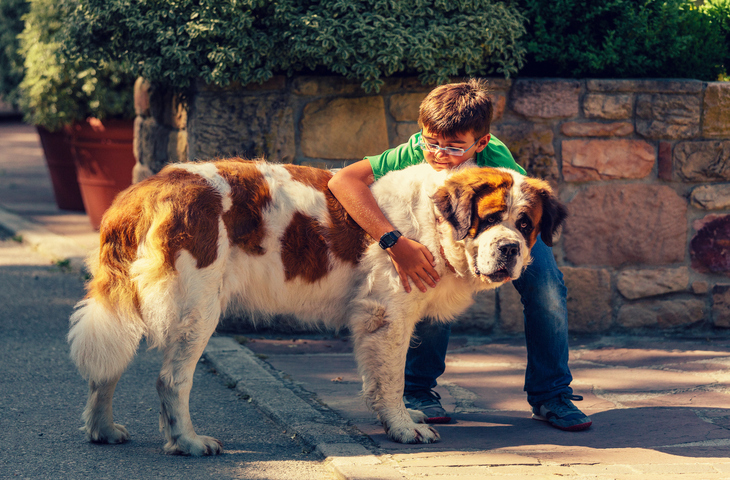Breed standard: FCI | Size: Large | Life expectancy: 8+ years | Temperament: Moyenne | Coat: Short or long | Origin: Switzerland.
With its striking but gentle appearance, the Saint Bernard doesn’t fail to impress. It is a faithful dog, with a pleasant character and kindness like no other.
The origins of the Saint Bernard
A rich history
The ancestors of the Saint Bernard dog breed originated in Asia. One of these ancestors was the Tibetan Mastiff, which still shows some resemblance to it. In Ancient Rome, Roman soldiers appreciated Tibetan Mastiff dogs and had them as companions. Thanks to their presence in Roman army camps, the dogs spread throughout Europe.
In the 17th century, traces of the breed were found in Switzerland, more precisely near the Italian- Swiss border, at the Hospice du Grand Saint-Bernard. Saint Bernard seemed to be a cross between the Tibetan Mastiff and local breeds from the Valais and the canton of Vaud. The Saint Bernard was bred this way to create a guard dog to protect the religious. It became known as a rescuer of lost pilgrims during the terrible Alpine winters. They rescued avalanche victims and lost travelers.
Their feats are recorded in many travelers’ accounts and we can read several testimonies in different Napoleonic soldier writings from around 1800. Between 1800 and 1814, no less than 40 people were saved by this impressive dog.
Recognition of the breed
The year 1867 is important when it comes to the Saint Bernard’s history. It was the year when the first documents relating to the genealogy of the breed were established by Heinrich Schumacher. The Livre des Origines Suisse was created 17 years later, in 1884, and mentioned the breed with Leon, the first registered dog, and his descendants. The same year, the Club Suisse du Saint-Bernard (Swiss St. Bernard Club) was created.
The breed was officially recognized, a year later, by the AKC (American Kennel Club).
The personality of the Saint Bernard
Despite its large size, this dog is gentle and devoted to its master.
Strong personality
Saint Bernards are particularly intelligent but can be a bit stubborn if not well-trained.
The breed is very protective of its owners and its home. They have an innate rescue instinct and will want to help anyone in trouble.
Needs love and affection
It is a very kind, calm, and affectionate dog. This dog breed is also very tolerant. Because of its gentle nature, it is an exceptional dog for children. However, small children should still be careful.
The Saint Bernard enjoys spending time with humans and does not like to be alone. It needs attention and has a hard time relaxing if it is not with its family. If this breed has to spend its days alone waiting for its owner to return, it can become depressed and destructive.
The breed’s calmness can be deceptive. It still needs exercise and likes to go on long walks with its owner.
Needs space
While this dog can live in an apartment, it must have enough space to get around easily, otherwise, it will be unhappy. It is best to take Saint Bernards out often so that they can move around freely and get some exercise. If you have a house with a garden, your Saint Bernard will be very happy.

The physical characteristics of the Saint Bernard
General
It is no secret that the main characteristic of this breed is its size. They can reach up to 90 cm (almost 3 feet)!
Head
The Saint Bernard’s head is wide. The top of the skull is domed with a forehead that falls straight down to the nose. The eyes are medium. The color can vary from brown to hazel.
Their large ears are set high and are rather short. The rounded pinna is soft and ends in a triangle.
Body
The back of the breed is broad and well-built. When it comes to the tail, it is long and massive.
The body of the Saint Bernard is powerful and firm.

Coat, color, and care
Coat
The dog may be:
- short-haired
- long-haired.
Shorthairs are rarer than longhairs. The coat has a white background with various colored markings. The white markings must, according to the standards of this breed, be present on the chest, feet, tail, around the muzzle, and on the muzzle.
Colors
The variations of the coat are mainly due to the color patches which can be very varied. For example, they can have a broad red-brown band on the back or have black or red-brown spots more scattered on the body.
The ears are always darker. The mouth is often marked with a red-brown mask that highlights the eyes.
Care
For short-haired dogs, brushing them once a week is sufficient. For long-haired dogs, it is preferable to brush your dog every day. Check the areas behind the ears and on the breeches regularly when brushing. These areas tend to mat more quickly. During the fall and spring molts, this dog sheds a lot. Brush as much as necessary.
This breed may experience some eye problems due to excessive tearing up. Their eyes must be cleaned regularly to wipe away the tears.
It is also important to keep an eye on the ears, which can get dirty quickly. You should also wipe its nose often to remove any traces of drool.
Did you know?
Saint Bernards are often depicted with a barrel around their neck. This is linked to the dog’s rescue activity. Today, there are other ways to help a lost traveler than offering him mulled wine! You can see symbolic images of this large dog breed at events dedicated to tourists. Nowadays, they are used less and less for rescues.
The barrel on the dog’s neck was first seen in Edwin Landseer’s 1820 painting “Alpine mastiffs resuscitating a traveler in distress” in the National Gallery of Art in Washington.
The Saint Bernard at a glance
Size: females measure around 65 to 80 cm while males measure around 70 to 90 cm.
Weight: females are lighter and way between 50 and 75 kg; males weigh between 55 and 90 kg (between 121 and 198 lbs) .
Health: There are many cases of elbow and hip dysplasia in this breed. The dog can also suffer from stomach enlargement. It will therefore be necessary to ensure that it eats slowly and remains calm after its meal.
The Saint Bernard’s eyes leak regularly and this can cause eye problems (entropion or ectropion).
The breed can also have heart problems such as dilated cardiomyopathy. It can also suffer from eczema and is very sensitive to heat.
Life expectancy: 8 to 11 years.
Is this breed good with children? The Saint Bernard is great with children. They stay quiet during cuddle time and play happily when children are up and ready to play. They keep an eye on young ones at all times and see to their safety.
Is the Saint Bernard easy to train? Saint Bernards should be trained as early as possible. Even though this breed is a bit strong-headed, it understands what is asked of him and will be happy to obey.
The training should be strict and firm. You must not let yourself be seduced by its sweet side because if it doesn’t obey, it will become very complicated when it becomes an adult!

